Author(s): Hamideh Fatemi, Ghorban Safaeian Layen*, Majid Azizi, Mohammad Jafari Ghodsi Pahmedani, Zahra Safaeian layen and Niloofar Momenian
To investigate and control quality, one must be able to measure quality-related attributes. Quality of produce encompasses sensory attributes, nutritive values, chemical constituents, mechanical properties, functional properties and defects.
MRI has great potential for evaluating the quality of fruits and vegetables. The equipment now available is not feasible for routine quality testing. The image and resolution produced by MRI is quite detailed and can detect tiny changes of structures within the body. For some procedures, contrast agents, such as gadolinium, are used to increase the accuracy of the images. MRI additionally quality, can even examine the histology, histochemistry and structural characteristics of samples. He also mentioned that MRI is used as an on-line sensor in postharvest sorting and processing situations. The equipment now available is not feasible for routine quality testing; however, costs and capabilities are rapidly improving. Each sensor method is based on the measurement of a given constituent or property; therefore, its ability to measure overall quality is only as good as the relationship of that constituent or property to quality as defined for a particular purpose. Improved statistical methods for combining the inputs from several measurements into classification algorithms are being developed.
Much effort nowadays is directed towards increasing the consumption of fruits and vegetables because of their health benefits. The attractiveness of horticultural crops with to respect the purchasing behavior of consumers is affected by visual appearance, but the expected internal quality is of equal importance (Patel, et al.).
Quality of produce encompasses sensory properties (appearance, texture, taste and aroma), nutritive values, chemical constituents, mechanical properties, functional properties and defects. Shewfelt points out that quality is often defined from either a product orientation or a consumer orientation.
Often empirical methods developed to measure some particular quality attribute actually measure ripeness. Physiological processes involved in ripening and senescence occur together in a fairly predictable pattern. For example, measuring color might appear to be adequate to estimate firmness in peaches and tomatoes at harvest. However, growing conditions or postharvest treatments may decouple the physiological processes such that indirect measurements no longer predict quality as expected-e.g., the fruit softens but the color does not change. So, it is essential to recognize what is really being measured and to respect the limitations of indirect measurement.
People use all of their senses to evaluate quality: sight, smell, taste, touch, and even hearing. The consumer integrates all of those sensory input’s appearance, aroma, flavor, hand-feel, mouth-feel and chewing sounds-into a final judgment of the acceptability of that fruit or vegetable. Instrumental measurements are preferred over sensory evaluations for many research and commercial applications because instruments reduce variations among individuals, are more precise, and can provide a common language among researchers, industry and consumers. However, the relationship of the instrumental measurement to sensory attributes (e.g., descriptive analysis) and the relationship of those sensory attributes to consumer acceptability must be considered (see Shewfelt).
Quality of fruits is a complex multicriteria concept defined not only by sensory attributes such as appearance, texture and taste but also by compositional characteristics, nutritional properties, ability to undergo storage and absence of defects. The quality is evaluated by many participants of the fruit production chain, each having different quality criteria and requirements. Whereas production yield, orchard management and disease resistance interest growers, the fruit freshness and durability are the main needs for distributors. Consumers use their five senses to evaluate fruit quality. Sight and touch are important for purchase decision, and the internal characteristics perceived by smell, taste and mouth-feel will determine the decision to repurchase (Butz, et al.).
During the past year, much progress has been made in developing nondestructive techniques for the assessment or inspection of quality parameters of fruits including internal disorders but also taste, sugar content, and so forth. As already emphasized in the research needs section, the ideal method covering all requirements of todays and future applications in production, storage, and retail has not yet emerged and probably will not be found in the foreseeable future (Butz, et al.).
Typical examples are analysis of tissue development during growth, physical tissue damage assessment (e.g., bruising), postharvest treatments to improve fruit quality and shelf-life (e.g., heat treatments or storage conditions), food processing (e.g., drying or freezing) and online quality assessment for sorting purposes. Several experimental techniques have been applied for these purposes (Falcone, et al.), such as X-ray computed tomography (Verboven, et al.); (Musse, et al.), near infrared spectroscopy (NIR, Clark, et al.; Nicolai, et al.), exploit the changes in density and water content of the affected fruit (Shahin, et al.), such as flotation methods (Porrit, et al.), light transmittance (Olsen, et al.) or thermography, Online detection by means of X-ray radiography has also been investigated (Shahin et al.; Kim and Schatzki) and X-ray computed tomography(X-ray CT) have also been successfully applied to detect internal disorders [1-4].
Certain nuclei, including 1H, 13C, 31P and 23Na, have a magnetic moment and align along a strong static magnetic field (Faust, et al.). The 1H magnetic resonance is of greatest horticultural interest. A weak pulse of the proper radiofrequency (RF, based on magnetic field strength) will cause the net magnetic moment to rotate 90°.When the RF signal is removed, the moment loses energy and relaxes back to its previous position. Energy released by relaxation induces an RF signal in a receiver coil. Energy loss is differential and is based on the environment surrounding each nucleus. T1 (spin-lattice) relaxation times represent energy loss to the surrounding environment (called the lattice), whereas T2 relaxation times (spin-spin) represent loss due to interaction of the spins of multiple nuclei with respect to each other. Images (MRI) are created by applying a magnetic gradient in one direction (phase encoding) and an RF gradient in the other direction (frequency encoding); gradients permit the reconstruction of spatial information. T2 values are often used to describe the biological state of tissues (Faust, et al.) and are generally interpreted as the ratio of bound water to free water.
Of particular interest in horticultural applications, areas of greater free water content are brighter than surrounding tissues in MRI, so that disorders involving water distribution-water core, core breakdown, chilling injury, bruising, decay, presence or feeding of insects, etc.-can be visualized. Applications of MR and MRI in horticulture have recently been reviewed by (Faust, et al. and Abbott, et al.) [5].
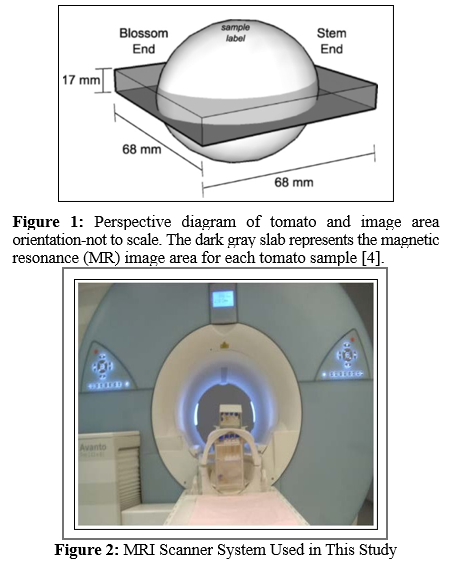
| Scanner Parameters Scanner data | |
|---|---|
| Scanner type | Siemens Avanto (Germany) |
| Field strength | 1.5 Tesla |
| RF frequency | 65 MHz |
| Coil used | Quadrature head coil |
| Pulse sequence | Multi-spin echo (CPMG) |
| TR (ms) | 3000 |
| TE (ms) | 22-704, TEn = 32(TEi =22) |
| FOV Read (mm) | 260, 230 |
| Matrix size | 512x512 |
| Slice thickness (mm) | 4 |
There is an increasing interest in making 2D MRI transferable for the food industry. From our point of view, the on-line implementation of this technique demands the fulfilment of three requirements: the use of ultrafast sequences (below 1 s), the acquisition of images under motion conditions in order to reach conveyor velocities close to the current ones (up to 2 m/s), and the use of appropriate technology for low magnetic field strengths, keeping in mind sample olarisation, magnet and probe designs, field homogeneity, compatibility with commercial graders and budgets as pointed out by Hills and Clark (2003). For instance, the conventional sequence based on gradient echoes fast low angle shot (FLASH), which can capture MRI images within less than 500 m s, has been accomplished under motion conditionsand applied for detection of freeze injury in oranges, seeds in mandarins, and internal breakdown in pears (Hernandez-Sanchez, et al.). As demonstrated in these studies, image artefacts from dynamic MRI can be removed with an appropriate slice selection and proper mathematical algorithms. Moreover, motion corrected images have been found statistically undistinguishable from static ones, making the image processing algorithms directly transferable from one condition to another. A new MRI sequence called combined spiral and radial acquisition (COMSPIRA) has recently been proposed (Rodriguez, et al.) for polarised gas imaging of lung with significant shortening of acquisition times and enhanced contrast as compared to FLASH, being much less sensitizing to motion artefacts. In this study, the new sequence was used for internal fruit quality assessment and compared with the conventional gradient echo sequence. The increasing feasibility of MRI for fruit quality assessment highlights automatic image segmentation and features extraction. The analysis of pros and cons for the different sequences regarding these post-processing methods becomes of increasing interest.
Quality of produce encompasses sensory properties (appearance, texture, taste and aroma), nutritive values, chemical constituents, mechanical properties, functional properties and defects [1].
Magnetic resonance imaging (MRI) is a noninvasive, nondestructive technology, which examines the distribution, and mobility of protons in water molecules and other concentrated metabolites in biological tissues (Clark and Foebes(. MRI technique has not yet used for this problem.
MRI makes use of the magnetic properties that some atomic nuclei have, especially hydrogen nuclei from water molecules. When placed in a magnetic field (such as in an MR instrument), the natural magnetic fields of the hydrogen nuclei re-orient themselves along the strong magnetic field of the scanner. This orientation may be perturbed by exciting those nuclei with a burst of electromagnetic energy (RF pulse).As these excited nuclei realign themselves with the scanner’s magnetic field, they emit a radiofrequency signal that can be detected by a receiver coil. The nuclei emit different signals depending on their surroundings. The contrast between various structures would be poor since tissues do not differ substantially in water content. However, there are numerous properties of the tissue water which can be exploited to provide contrast and these can be used to obtain another useful information [6].
MRI makes use of the magnetic properties that some atomic nuclei have, especially hydrogen nuclei from water molecules. When placed in a magnetic field (such as in an MR instrument), the natural magnetic fields of the hydrogen nuclei re-orient themselves along the strong magnetic field of the scanner. This orientation may be perturbed by exciting those nuclei with a burst of electromagnetic energy (RF pulse).As these excited nuclei realign themselves with the scanner’s magnetic field, they emit a radiofrequency signal that can be detected by a receiver coil. The nuclei emit different signals depending on their surroundings. The contrast between various structures would be poor since tissues do not differ substantially in water content. However, there are numerous properties of the tissue water which can be exploited to provide contrast and these can be used to obtain another useful information [6].
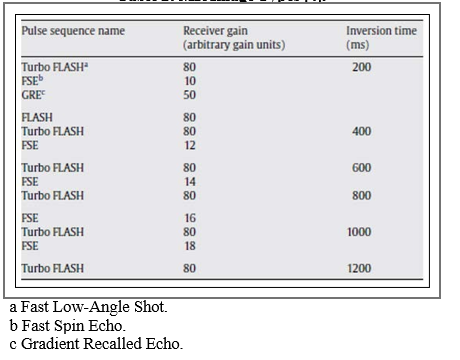
Typical examples are analysis of tissue development during growth, physical tissue damage assessment (e.g., bruising), postharvest treatments to improve fruit quality and shelf-life (e.g., heat treatments or storage conditions), food processing (e.g., drying or freezing), seeds or pits, voids, pathogen invasion, worm damage, and online quality assessment for sorting purposes, have been used by MRI (Saltveit; Akimoto, et al.; Faust, et al.) [7, 8]. These are many important type of physiological disorder was measured by MRI:
Some damaged fruit, such as those with large cracks in the skin, are obvious upon visual inspection and could be sorted by hand. In addition, some fruit appearing to be sound are heavily damaged. It would be difficult to sort these fruit by color or visual appearance because bruising does not cause sufficiently detectable changes in these attributes. Bruising in fruit is the result of mechanical damage caused by compression or impact forces. Bruised flesh typically manifests as a dark, well defined area close to the impact site. It is developed in response to two subsequent processes in fruit tissue that take place at the cellular level: tissue disruption with cell wall failure and release of cytosolic components from cells, and enzymatic activities in the disturbed environment of the cells and tissues (Linden and Baerdemaeker; Mazhar, et al.).
Bruising is an aesthetically, physicochemically, and economically important postharvest problem that has been studied in many fruits and vegetables, such as apple (Zion, et al.; Toivonen, et al.) and tomato (Linden and Baerdemaeker).
Water core is a physiological disorder affecting apples and pears when the fruit is still attached to the tree (Yamada, et al.; Melado- Herreros, et al.). Normally, water core starts around the vascular bundles (Kasai and Arakawa) and, except in some particular cultivars, symptoms are not visible from the exterior of the fruit. It is thus an internal disorder, characterized by water-soaked, glassyregions in the fruit flesh and involving the appearance of fluid-filled intercellular spaces with elevated sorbitol rates (Marlow and Loescher). In mild cases, water core may disappear during storage, but in more severe cases, internal breakdown can occur (Bennedsen and Peterson) and alcoholic off flavors develop
(Dart and Newman, 2005). In some varieties and in some parts of the world, such as Japan, it is considered as an indicator of full ripeness and they are called ‘honeyed apples’ (Kasai and Arakawa).
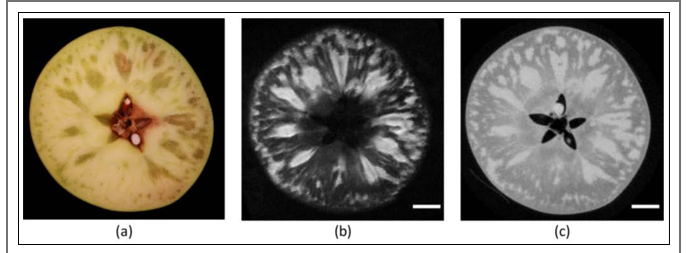
Figure 3: Visual Evaluation of Watercore Disorder in Rebellon Apple after Cutting the Fruit at the Equator (a) and the Corresponding MRI (b) and CT Images (c). The MRI Imagewas Exactly Matched to the CT Image because we Obtained 3D data. The Photograph is from Approximately the same, however obviously not identical, position. Scale Barsmeasure 10mm.
Mealiness is a negative attribute of sensory texture that combines the sensation of a desegregated tissue with the sensation of lack of juiciness (Barreiro et al.). Textures in many fruit like peach, are also known as woolliness and leatheriness. In woolly textures, the lack of juiciness is caused by gel structures that retain the water molecules (Kailasapathy K, Melton). While the lack of juiciness in mealy apples is due to the lack of rupture of the cells which separate due to the weakness of the middle lamella (De Smedt, et al.). In Previous project mealiness assessment in apples and peaches through mechanical tests.
A number of noteworthy methods have been used to correlate the changes of apple texture, internal structural quality and mechanical properties associated with mealiness with sensory assessment by a panel of experts (Harker, et al.; Hoehn, et al.; Arana, et al.). However, these methods involvewell-trained personnel and high economic costs so cannot be used for routine on-line sorting.
Characterization of intercellular air spaces in relation to microstructural properties thus has important applications to understanding of several phenomena such as postharvest quality or shelf life of the fruit (Mendoza, et al.; Musee, et al.). For example, apple fruit with greater fractional air volumes have been shown to be softer (Yearsley, et al.) or mealier (Tu, et al.) and to have higher internal gas diffusion rates (Ho et al.). The volume of intercellular air spaces continues to increase during apple storage. Its measurement can therefore be used to define the age of a fruit and also to characterize the effects of different storage conditions on its quality (Ho, et al.). However, the role of gas transfer in the occurrence of disorders is still not fully understood, one of the main reasons being that quantification of the intercellular air spaces is difficult.
It is difficult to identify an infestation from outside the fruit. Infestation by larvae of the insect deteriorates the quality of products and leads to a loss of reliability in production areas. Pesticides are used periodically, based on ecological studies of the moth (Narit; Ishiguri & Toyoshima), to avoid severe damage, and fruits are carefully examined by the human eye during harvesting and cargo booking. For this reason, infested fruits are seldom sold on the Japanese market. But, to avoid the larvae infestation completely, a new method is needed.
Larvae frequently entered the fruit near the calyx and tended to infest around the coreline vasculature where sugars accumulate. These larval functions are to be investigated further in relation to the growth stages of the fruit, strains of larvae and environmental circumstances that influence the movements and actions of the insect (Haisi, et al.).
MRI has already been shown to be an effective technique for internal quality assessment in a wide variety of fruit species: apple, avocado, blueberry, cherimoya, courgette, cucumber, durian, kiwifruit, mandarin, mango, melon, nectarine, olive, onion, orange, papaya, pear, peach, pineapple, potato, tangarine, tomato, strawberry, melon, and watermelon (Hills and Clark, 2003). Furthermore, since, fruits and vegetables are capable of absorbing radiofrequency (RF) energy and being stimulated in a (1H) MRI experiment due to presence of a multitude of proton- containing species. The H atoms associated with water molecules selectively targeted for imaging in biological material because of their high abundance [9, 10].
For apple fruit in particular, MRI has already been applied to analyses: (1) changes within the tissue during ripening and storage (Letal, et al.); (2) internal quality defects such as voids, worm damage or bruising and their variation over time (McCarthy, et al.; Zion, et al.); (3) the 3D vascular structure; (4) the microporosity (air volume) of apple (Musse, et al.); (5) temporal degradation of apples by water core (Marlow and Loescher; Cho, et al.; Melado- Herreros, et al.; Herremans, et al.), internal browning (clark; Chayaprasert and Stroshine; Cho, et al.)or mealiness (Marigheto, et al.); (6) drying of apple (Hills and Remigereau; Nguyen, et al.); (7) transport properties and chemical composition of apples (Verstreken, et al.; Keener et al.); (8) Detection of Infestation of Carposina sasakii Matsumura (Haishi, et al.); and (9) water compartmentation in apple tissue (Snarr and Van As) [7, 8, 11-15].
This study demonstrated that MRI can detect nonvisible internal bruise and spraing symptoms in potatoes, which has not been published before. MRI may, therefore, be an appropriate method for detecting and for studying developmental changes of such disorders and related disorders during postharvest storage in future experiments, monitoring sprouting of Onion (Fatemi, et al.). MR-imaging besides giving well-known information aboutwater distribution also gives information about anatomic structures within raw potatoes, which are of importance for the perceived textural properties of the cooked potatoes [16].
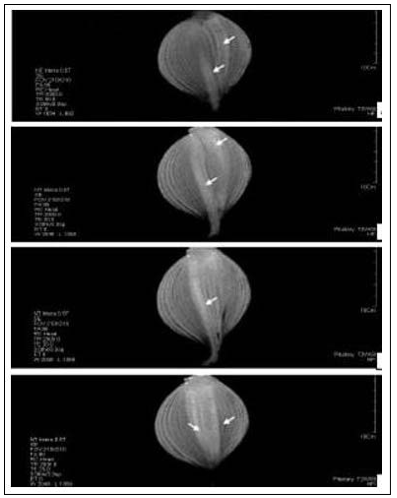
Figure 4: MR images of comparable cross-sections of onion in sprouting stage (Fatemi, et al.).
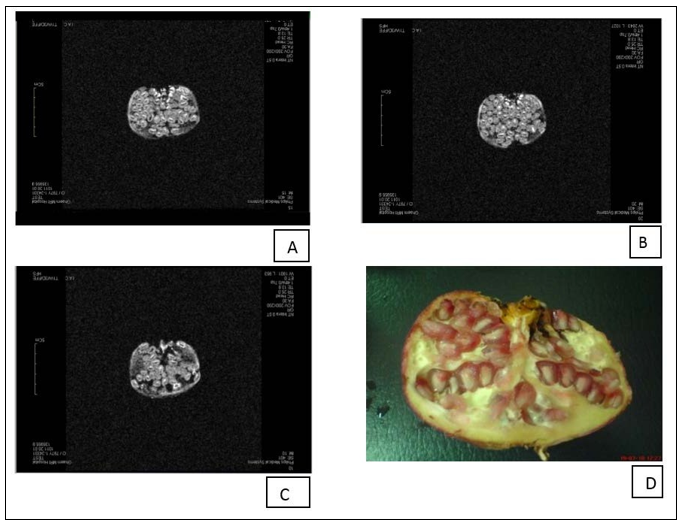
Figure 5: A-C T1 imaging of MRI Carob moth (Ectomyelois ceratoniae Zeller (Lep: Pyralidae) in pomegranate, D- digital imaging (Fatemi, et al.)
Tomato (Solanum lycopersicum L.) is one of the most importanthorticultural crops both economically (Beckles, et al.; Tao, et al.) and as agenomics, molecular, biochemical, and physiological model for bio-logical processes occurring in fleshy fruits (Seymour, et al.).
Tomato maturity is one of the most important factors associated with the quality of processed tomato products. Physiological changes in tomato at different maturity stages can be encoded in MR image signal intensity (Zhang, et al.). In general, MIA of MR images of tomato proved to be effective for predicting the conductivity score of pericarp tissue in tomatoes. Future development of this technique will relate MRI measured membrane integrity to other relevant quality indices, such as peel-ability (for processing tomatoes). The present analysis was performed only on tomato pericarp tissue, and it is possible that cell membrane integrity in other tissues would have an effect on peel-ability. For example, the state of the epidermis, especially at its attachment point on the stem scar, may also affect peel-ability. The cross- sectional area of tomato epidermis is very small relative to the length scales that can be achieved with current MR imaging systems and tomatoes [17].
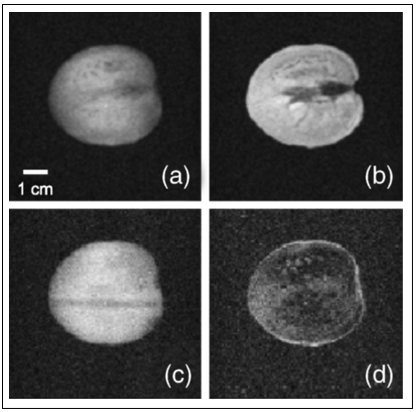
Figure 6: Example magnetic resonance (MR) images of a damaged sample. All images depict the same plane of the fruit and have the same field of view (68mmx68mm) and resolution (1.1 mm/ pixel), but were generated by different MR pulse sequences. The MR pulse sequences represented are Fast Spin Echo with Receiver Gain = 10 (a), central slice of 3D Gradient Recalled Echo (b), Fast Low-Angle Shot (c), and Turbo Fast Low-Angle Shot with inversion time = 800ms (d). All pericarp in this fruit was damaged.
Broccoli is one of the most favorite vegetables for many consumers due to its high nutritional value and the bio-active components that contribute to the health (Jin, Oliviero, et al.; Lv, et al.; Molmann, et al.; Xin, et al.). The high moisture content of fresh broccoli renders it susceptible to spoilage (such as softening, yellowing, loss of nutrients) (Kebede et al.; Shi et al.). As a result, the shelf life of fresh broccoli is short.
Dehydration of radishes, woolly breakdown in nectarines (Sonego, et al.), changes in the texture in melons (Hall, et al.) and mechanical injuries in guavas (Mattiuz, et al.), quantifying chilling injury in cucumbers (Kuo and Parkin) and mechanical damage to popcorn kernels, voids and bruises in various apples and melons [6, 7, 18, 19].
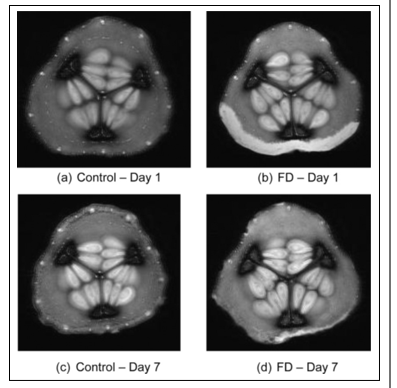
Figure 7: MR images of comparable cross-sections of control and FD cucumber samples at 1st and 7th day of storage after inducing freeze damage
MRI has become a well-established technique for the analysis of fruit and other food due to the following features: (1) MRI is non-intrusive hence non-destructive, which allows monitoring of intact samples (e.g., fruit) over time; (2) MRI is very suitable for fruit, due to their high water content and the sensitivity of MRI to quality parameters affecting the fruit (e.g., browning); (3) 3D high spatial resolution information on the internal fruit structure is available (typical slice thickness ?100-1000 _m; resolution in 2D slice ?10-50 _m; voxel volume ?10 nL); (4) different parameters related to the microstructure, water distribution and its mobility can be measured (proton density PD, T1 and T2 value, self-diffusion coefficient), which often provide complementary information; and (5) different substances (e.g., water, oil and sugar) can be distinguished [5].
Although, MRI techniques have great potential for evaluating the internal quality of fruits and vegetable but although it isn’t practical for routine quality testing. MR equipment is expensive and difficult to operate; but, like all technologies, it is becoming cheaper, faster and more feasible for research and specialized applications.
Another disadvantage of MRI is that it requires long measurement times because its sensitivity is low compared with optical and molecular biological methods. The issue of measurement time has severely restricted the development of applications using MRI
Quality is not a single, well-defined attribute but comprises many properties or characteristics. Statistical combination ofmeasurements by several sensors will increase the likelihood of predicting overall quality. However, sensor testing and calibration must include a wide range of conditions. It is important that what is really being detected is understood so the limitations are appreciated. Of course, there are different requirements for laboratory and industry applications. Appearance is one of the major factors the consumer uses to evaluate the quality of fruits and vegetables, and measurement of optical properties has been one of the most successful instrument techniques for assessing quality. Many products are routinely sorted for color [1, 20-29].
There are a lot of technique for imaging of fruit and vegetable but among these imaging techniques, magnetic resonance imaging (MRI) can provide better contrast and substantial information related to the molecular constituents and water proton distribution. An MRI (or magnetic resonance imaging) scan is a radiology technique that uses magnetism, radio waves, and a computer to produce images of body structures. The MRI scanner is a tube surrounded by a giant circular magnet. The patient is placed on a moveable bed that is inserted into the magnet. The magnet creates a strong magnetic field that aligns the protons of hydrogen atoms, which are then exposed to a beam of radio waves. This spins the various protons of the body, and they produce a faint signal that is detected by the receiver portion of the MRI scanner.
